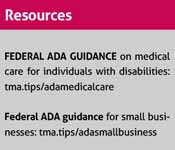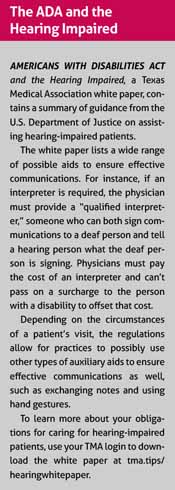
If someone asked you about your training on federal requirements for accommodating patients with disabilities, would your answer sound something like this?
“Oh golly. I have no idea. I’m sure I had to read or study something sometime. I’ve been doing this a long time. I’ve been a doctor for quite a while, so I suspect I had to learn it somewhere, but I don’t remember where.”
That’s an actual answer from one internal medicine physician in a recent study of doctors’ knowledge of their legal obligations under the Americans with Disabilities Act (ADA). And if the results of that small study are any indication, many physicians might be lacking in their knowledge on the subject.
The law carries mandates most physician practices must follow to make their offices accessible so as to not discriminate against patients with disabilities when providing care. And five years ago, the government raised the penalties for failing to do so. So it might be time to educate, or re-educate, yourself on what the ADA requires.
“From a regulatory standpoint, the cost of not doing it is great enough that there should be efforts made to learn about what needs to be done to be compliant, just like you would with anything else,” said Fort Worth family physician Linda Siy, MD, a member of Texas Medical Association’s Council on Legislation.
As an employed physician in a group that contracts with a county health district, she treats many Medicaid patients with disabilities. ADA compliance, she said, is not an issue “that we talk about much or provide training on much in our professional organizations, and maybe it should be.”
Spaces, table heights, and more
An April 2019 study by Massachusetts General Hospital and two universities examined physicians’ knowledge of legal obligations when caring for patients with disabilities. Researchers interviewed 20 physicians in several specialties, with an average of 27 years in practice. Out of those 20, four reported receiving formal training about their ADA-related obligations to patients with a disability; 12 said they hadn’t received any such training; and four were unsure. Just one participant had received the training in medical school.
The study said most physicians interviewed “exhibited a superficial or incorrect understanding of their legal responsibilities to patients with a disability.”
If you feel you’re in that boat, you might want to consult federal guidance with information and common questions physicians ask about their ADA obligations. (See “Resources,” page 41.)

The ADA defines a person with a disability as someone with “a physical or mental impairment that substantially limits one or more life activities”; someone with a record of such an impairment; or someone who is “regarded as having such an impairment.” Among the ADA standards required for accessible exam rooms, according to the guidance:
• The entry door to the exam room should be a minimum width of 32 inches when the door is opened at a 90-degree angle;
• There should be a minimum of 30 by 48 inches of clear floor space next to the exam table; and
• An accessible exam table should be able to be lowered to the height of the patient’s wheelchair seat, 17 to 19 inches from the floor.
Federal guidance also includes requirements on removing architectural barriers, accessible parking, and entrance and maneuvering spaces – which apply to both for-profit and nonprofit organizations. Among them:
• Designated accessible parking spaces must be included among any parking the business provides for the public “if doing so is readily achievable.” Those parking spaces should be the closest to the accessible entrance, on level ground. The spaces should be at least eight feet wide, with an access aisle on either side.
• For accessible spaces for cars, the adjacent access aisle must be at least five feet wide; for van spaces, eight feet wide.
• If achievable, an accessible service counter must have a maximum height of 36 inches, with a clear floor space of 30 by 48 inches to permit the use of a wheelchair.
Hearing-impaired patients present their own considerations for delivering adequate care. TMA’s white paper, Americans with Disabilities Act and the Hearing Impaired, contains a summary of physicians’ requirements for those patients under the ADA and guidance from the Department of Justice (DOJ) on how they may be able to meet those requirements. (See “The ADA and the Hearing Impaired,” left.)

Penalties stiffer than ever
Dr. Siy calls the results of the Massachusetts General Hospital study “pretty typical.” She believes physicians could benefit from more knowledge on the topic as early as residency training – in light of both regulations and the long-standing cottage industry of attorneys who sue small businesses for alleged ADA violations.
“That’s just something as a business owner you have to be aware of and comply with, just like you do with other regulations within whatever city you live in, whether it’s smoking regulations or OSHA (Occupational Safety and Health Administration) regulations,” she said.
In 2014, DOJ substantially increased ADA penalties for small businesses. The maximum fines are now $75,000 for a first-time violation – $20,000 higher than the previous maximum – and $150,000 for any subsequent violations.
Tex Med. 2019;115(12):40-41
December 2019 Texas Medicine Contents
Texas Medicine Main Page